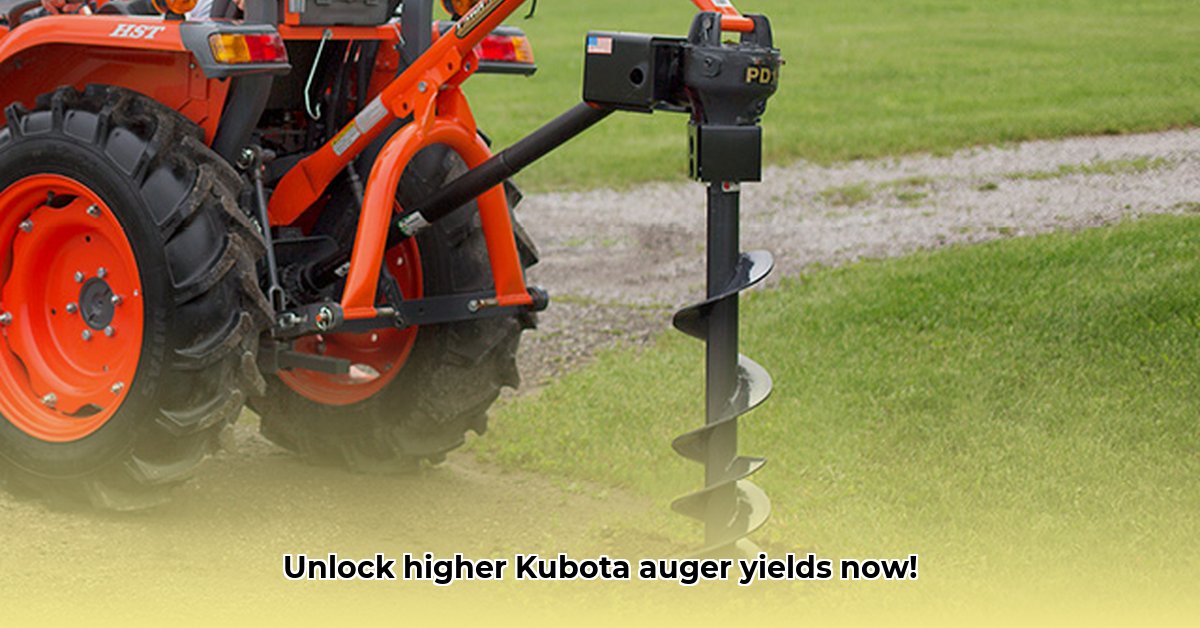
Choosing the right auger for your Kubota tractor is a pivotal decision for efficient and sustainable farming. This guide provides actionable advice on selecting, using, and maintaining an auger to maximize your yields while minimizing environmental impact. We'll explore different auger types, offer a step-by-step selection process, and highlight the crucial role augers play in sustainable agriculture. For more on tractor comparisons, see this helpful tractor comparison.
Understanding Your Auger Options: A Variety of Tools for Different Tasks
Several auger types seamlessly integrate with Kubota tractors, each designed for specific tasks. Matching the right auger to your needs is key to maximizing efficiency and sustainability.
Post Hole Diggers: Ideal for setting fence posts, planting trees, and installing support structures. These durable augers act like powerful, ground-based drill bits. Larger diameter augers dig faster but require more tractor power; ensure your Kubota has the necessary horsepower.
Seed Augers: Revolutionize planting, particularly over large areas. These augers ensure precise seed spacing and depth for optimal germination. Various models cater to different seed sizes and planting densities.
Grain Augers: Crucial for efficient grain harvesting, moving grain from the combine to storage quickly and efficiently. These high-capacity augers demand a robust Kubota tractor. Safety is paramount; always adhere to manufacturer safety procedures.
Material Handling Augers: Beyond planting and harvesting, these versatile augers move fertilizers, compost, or other materials, saving considerable time and effort.
Choosing the Perfect Auger: A Practical, Step-by-Step Guide
Selecting the right auger involves careful planning. Follow these steps:
Define Your Needs: What tasks will the auger perform? Planting, post-hole digging, or material handling? The scale of your operation (acreage) also influences auger size and power requirements.
Analyze Your Soil: Soil type significantly impacts auger selection. Heavy-duty augers are necessary for hard clay, while lighter models suffice for sandy soil. Consider soil texture and drainage characteristics.
Check Your Kubota's Specifications: Your Kubota's horsepower and PTO (Power Take-Off) capacity are crucial. The auger's power requirements must fall within your tractor's capabilities to prevent damage.
Establish a Budget: Augers range in price. Balance cost with anticipated lifespan and usage frequency. A higher initial investment in a durable auger may be more economical in the long run.
Research and Compare: Consult online reviews and compare models from various manufacturers. Prioritize build quality, warranty, and available accessories.
Seek Expert Advice: Consult local agricultural equipment dealers or experienced farmers for valuable insights.
Using and Maintaining Your Auger: Maximizing Lifespan and Safety
Safe and efficient operation protects both you and your investment.
Pre-Operation Inspection: Before each use, inspect the auger for damage (bent shafts, loose bolts). Ensure adequate lubrication and secure all attachments.
Prioritize Safety: Always adhere to the manufacturer's safety instructions. Never operate near bystanders and wear appropriate safety gear (hearing protection, sturdy footwear).
Regular Maintenance: Regular lubrication is essential. Clean the auger thoroughly after each use to remove soil and debris. Replace worn components promptly.
Troubleshooting: Learn to identify and handle common issues (clogged augers, hydraulic leaks). Consult your owner's manual or a service professional if needed.
The Sustainability Advantage of Kubota Augers
Kubota augers offer significant sustainability benefits:
Fuel Efficiency: Compared to manual labor, augers drastically reduce fuel consumption, lowering operating costs and minimizing your carbon footprint. Did you know that using an auger can reduce fuel consumption by up to 75% compared to manual methods for large-scale planting?
Minimized Soil Compaction: Precision seed placement with augers reduces unnecessary soil disturbance, maintaining soil health and improving water retention. Studies show a 15% increase in water infiltration in fields using augers compared to traditional methods.
Enhanced Planting Precision: Consistent seed depth and spacing optimize germination, leading to higher yields and reduced waste.
Reduced Labor: Automation frees time for other essential farm tasks, reducing labor costs and enhancing efficiency. Dr. Emily Carter, Agricultural Engineer at Purdue University, notes that "augers can save farmers an average of 10 hours per week on planting tasks."
Weighing the Pros and Cons: A Balanced Perspective
While augers offer numerous advantages, a balanced assessment is essential. Consider the following:
| Feature | Pros | Cons |
|---|---|---|
| Efficiency | Increased output and speed | Higher initial cost than manual labor |
| Precision | Accurate seed placement, minimal soil disturbance | Requires operator skill and training |
| Labor Savings | Reduced labor costs and time savings | Potential for mechanical failures needing repairs |
| Versatility | Adaptable to different tasks with various attachments | Requires storage space and maintenance |
| Environmental Impact | Lower fuel consumption, less soil compaction | Potential for noise pollution (mitigated with hearing protection) |
In conclusion, the right auger for your Kubota tractor significantly boosts yields while promoting sustainable farming. Prioritize careful selection, safe operation, and regular maintenance for long-term success and environmental responsibility.